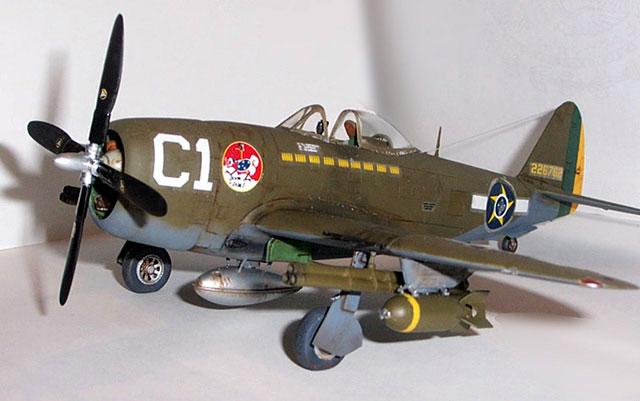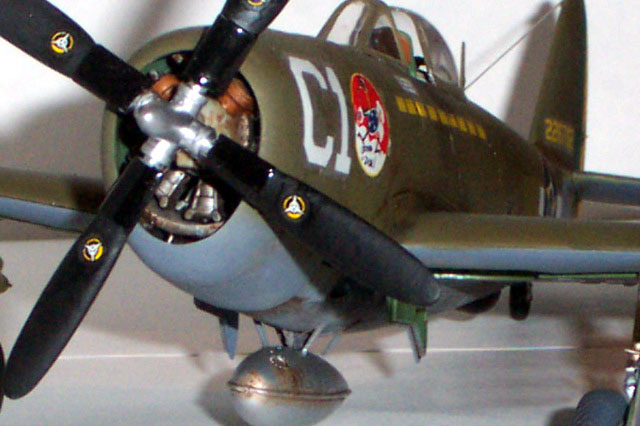|
P-47D Thunderbolt
by Flavio da Fonseca
|
 |
|
P-47D Thunderbolt |

HyperScale is proudly supported
by Squadron.com
Brazil entered WWII in the final years of the conflict, in 1944.
Two arms of the Brazilian Armed Forces were sent to Italy: the Força
Expedicionaria Brasileira (Brazilian expeditionary Force), from the
Brazilian Army; and the 1º Grupo de Aviação de Caça (1st Brazilian
Fighter Squadron – 1st BFS), from the Brazilian Air Force (or FAB, from
the portuguese name).
The 1st BFS, consisting of 350 crew and 43 pilots, was sent to Livorno,
Italy, on October 1944, where it became part of the 350th USAAF Fighter
Group. The 350th was subordinated to the 62nd Fighter Wing, XXII
Tactical Air Command, 12th USAAF. At that time, the 350th was made up of
three squadrons and the 1st BFS became its 4th squadron, operating from
the Tarquinia air base. Because P-47D Thunderbolt was the standard
equipment used by the 350th, that was the chosen aircraft to equip the
1st BFS, and not the P-51D Mustang.
Initially, the Brazilian P–47s were finished in standard US fighter
colors, olive-drab on top surfaces over neutral gray on the
undersurfaces (exception made for those aircraft of the commander and
operations officer which were finished in natural metal and olive-drab
anti-glare panels). The aircraft code (flight letter-aircraft number)
was painted in white letters over the cowling, and the badge of the
Group was painted after the engine cowling. The Badge consists of a
caped and armed ostrich over a red sky (see attached badge figure), and
was designed while the Squadron was traveling to Italy aboard the
transport ship UST Colombie, by a group of its pilots. The choice of an
ostrich to represent the pilots is at least curious: prior to their
departure to Italy, many pilots went to the US for training. During
their stay, they got acquainted to American military food: baked beans,
powder eggs and powder milk, etc. When they came back to Brazil, one of
their commanders called them “ostriches” because they were able to eat
such “junk food”. The nickname caught.

The National insignia was initially the FAB star, in four positions on
the aircraft, but after a few problems of misidentification (some
airplanes were shot at by allied fighters), a blue disc and bars were
painted around the star, to make it similar to the USAAF insignia. The
original star was retained on the right wing (as can be seen in the
featured model).
Although the Brazilian pilots were trained as fighters, the 1st BFS
became a fighter-bomber unit in Italy, and its missions were mostly
armed reconnaissance and “free-hunt” sorties, giving air support for the
US 5th Army, to which the Brazilian Expeditionary Force was attached. By
April, 1945, the group of pilots had been reduced to 24, some were KIA,
injured and others were taken as POWs. Every pilot flew an average of 2
missions a day, and at the end of the war the group had flown 445
missions, 2,550 individual sorties and 5,465 combat flight hours. They
achieved outstanding efficacy, and between 6 to 29 April 1945, although
flying only 5% of the total missions carried out by the 350th, the FBS
was responsible for the destruction of 85% of the ammunition depots
destroyed by the 350th, 36% of the fuel depots, 28% of the bridges, 15%
of motor vehicles and 10% of horse-drawn vehicles. Such achievements
rendered the 1st BFS the Presidential Unit Citation (Air Force), given
by the US Government. Apart from other few USAF units, only the 1st BFS
and two Royal Australian Air Force units - Nos. 2 and 13 Squadrons -
have received this citation.
More information can be found at:
http://www.rudnei.cunha.nom.br/FAB/eng/1gavca.html
http://www.sentapua.com.br/
Academy's 1/48
Scale P-47D
|
This is the Academy/HTC 1/48 Republic P-47D Thunderbolt (a very
limited edition). The model depicts the aircraft flown by Cpt. Fortunato
de Oliveira, with 56 missions. It was basically built straight from the
box, with a few modifications.
Overall, the Academy model has nice engraved panel lines and a good fit
(fill with putty was only eventually necessary). The cockpit was not
particularly detailed; therefore I am not going to describe it. For
painting, I started by pre-shading and then priming the model with
Testor’s neutral gray. I should point out that I darkened it a little
bit with flat-black because the gray undersides looked really darker in
the color photography that I had as reference. After priming, the upper
surfaces were sprayed with Testor’s olive-drab. The green-yellow rudder
was painted afterwards.
Weathering was done with a wash of brown artist’s oil, for the panel
lines and oil/fuel drips. Black pastel was used to represent exhaust and
cannon stains, as well as dirty parts on the cockpit access (root of the
wings and fuselage) and cannon compartment covers. Paint chipping was
done using silver enamel applied with a sharpened toothpick. Everything
was sealed in with several layers of flat lacquer.

One flaw to the kit was the decals. They were a little too thick and
opaque, and the translucent edges of individual decals can be seen in
many of the pictures. I tried to smooth them with semi-gloss coats, then
flat coats, but nothing really worked. Then I realized that I should
have cut the edges of before applying the decals. I guess was a bit too
late…
Extra details include antenna (from stretched sprue), break lines,
seatbelts (made from tape) and a new pitot tube made from brass wire
(not because I think it is better this way, but because I just lost the
original…)
The model was recently finished and the date on some of the photographs
is not correct. I forgot to set the date on my camera… that happens when
you’re excitedly taking pictures late at nigh after you just finished
the plane…
Click on the thumbnails
below to view larger images:
Model, Images and Text Copyright © 2003 by
Flavio da Fonseca
Page Created 20 August, 2003
Last Updated 17 March, 2004
Back to HyperScale
Main Page
|
Home |
What's New |
Features |
Gallery |
Reviews |
Reference |
Forum |
Search